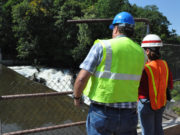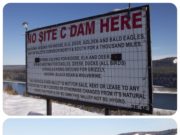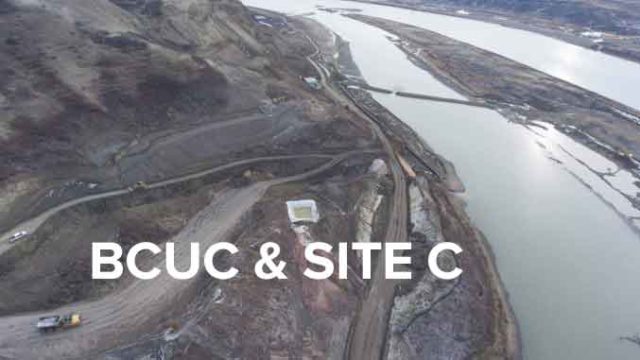British Columbians are facing a crucial test in the coming weeks – reaching an opinion on the planned Site C dam.
Currently estimated to cost $8.8 billion, the hydroelectric dam on the Peace River is the single most expensive public infrastructure project ever proposed in B.C. history.
Originally put forward along with a series of three other dams in the 1950s, Site C has been rejected twice already – in 1982 and 1989 – following hearings by the B.C. Utilities Commission (BCUC).
If built, the dam will flood an 83-kilometre-long stretch of the river to generate 1,100 megawatt hours of electricity, enough to power 450,000 homes per year.
Late on September 20, the BCUC issued a 205-page preliminary review of the project in which the commission said it needed a lot more answers before it could recommend definitively whether the dam idea should be abandoned, mothballed or allowed to proceed as scheduled.
The commission usually reviews proposed new energy projects like Site C, but the previous Liberal provincial government exempted Site C from such scrutiny when it gave BC Hydro the go-ahead to construct the dam in 2014.
In an order in council (OIC) dated August 2, 2017 B.C.’s newly-elected NDP government directed the BCUC to advise on completing the Site C project by 2024, as currently planned; suspending the Site C project, while maintaining the option to resume construction until 2024; and terminating construction and remediating the site.
The OIC went on to ask the BCUC to decide whether the project is proceeding on time and on budget; to estimate the cost to BC Hydro ratepayers of each of the three options, and to determine whether alternative energy sources or initiatives could provide energy at a similar or lower unit cost.
And the BCUC is to deliver all the answers to those questions in a final report due November 1 to Michelle Mungall, the Minister of Energy, Mines and Petroleum Resources, who has responsibility for BC Hydro.
Community input forum
But first, the BCUC’s Site C inquiry panel of four commissioners will conduct 11 community input forums in nine cities and four First Nation input sessions to gather public feedback on the preliminary report.
The public input forums begin on September 23 and conclude October 11. A public input session will be held in Nelson on September 26 from 6 p.m. to 10 p.m. at the Best Western Plus Baker Street Inn & Convention Centre, 153 Baker St.
The BCUC had previously invited members of the public to submit written data and analysis within the scope of the inquiry by August 30. It had also engaged Deloitte LLP, a professional services firm, to provide independent data and analysis based on the questions set out in the OIC.
Deloitte’s review found scenarios in which Site C could cost 50% more than budgeted. Using figures from BC Hydro and Deloitte, the panel agreed that about $2.1 billion has been spent on the project to date and that terminating it and remediating the site would cost another $1.1 billion.
All of those submissions can be viewed or downloaded on one of the commission’s inquiry web pages.
The Clean Energy Association of B.C., Sierra Club BC, Peace Valley Landowner Association, Canadian Centre For Policy Alternatives, Canadian Geothermal Energy Association, BC Pulp and Paper Association, Independent Contractors and Business Association, and David Suzuki Foundation were among groups submitting comments, in addition to more than 100 individuals.
Majority opinion opposed to Site C
The majority of submissions express opposition to the construction of Site C.
Among those who wrote in opposition were Harry Swain (who chaired the federal-provincial review panel of the project) and Marc Eliesen (CEO of BC Hydro from 1992 to 1994, and former head of Manitoba Hydro and Ontario Hydro).
“Demand will not materialize at even the low limit of BC Hydro’s demand forecast,” Swain wrote. “The issue is that BC Hydro’s 2016 load forecast is no more credible than its numerous predecessors.”
An April 2017 study from UBC’s Program on Water Governance found BC Hydro has over-forecast demand since the 1980s. It said electricity from the dam would be 100% surplus upon commissioning in 2024.
“Both the former government and BC Hydro’s Board abdicated their fiduciary responsibility to the rate payers and tax payers of this province,” Eliesen said in his submission. “There never was a business case for the start-up of construction of Site C, and there is not a business case to support its continuation or postponement.”
My own opposition to Site C goes back to the 1980s when I served as president of the Society Promoting Environmental Conservation. In 1982 SPEC published research showing the power from Site C was not needed. Thankfully, the BCUC listened then.
Today, I have five reasons why Site C should be stopped:
Reason 1: Federal and provincial government approval of Site C based on false info
The report Comparative Analysis of Greenhouse Gas Emissions of Site C versus Alternatives states: “The Site C dam does not deliver energy and capacity at significantly lower greenhouse gas emissions than a fully optimized Alternative Portfolio put forward by BC Hydro (which includes wind energy). The difference in lifecycle GHG emissions, if a difference exists at all, is at most 1% of BC’s current emissions.”
It goes on to say this is vitally important because “Site C has more significant adverse environmental effects than any project ever reviewed under the history of the Canadian Environmental Assessment Act, including impacts on dozens of species, aquatics, vegetation, wildlife, Aboriginal use of lands and resources, and cultural heritage. The federal and provincial governments stated that the unprecedented level of significant adverse environmental effects from Site C are justifiable, in part, because the project delivers energy and capacity at substantially lower GHG emissions than the available alternatives. Our analysis indicates this is not the case,” says the report prepared for the Program for Water Governance at UBC.
Reason #2: The world needs to transition to smart and efficient energy demand
The Rocky Mountain Institute calculates that 60% of generated electricity is used by buildings. As the biggest consumers of power, buildings can literally make or break the critical transition to a low-carbon energy future, RMI concludes. Most of the homes and commercial buildings that will be in use by mid-century are already standing. On average, they need to be twice as energy-efficient by 2050. Architecture 2030 believes they can become net-zero buildings, producing as much energy as they consume.
Keeping average global warming below 2°C is both possible and practical given the rapidly falling cost of renewable energy, the Rocky Mountain Institute concludes in their new analysis Positive Disruption: Limiting Global Temperature Rise to Well Below 2 C°. In 2016, for example, renewables met more than half of global growth in electricity demand, and in that year alone, prices fell 37% for the lowest Mexican solar-power bids and 43% for Europe’s best offshore wind bids.
“In periods of fundamental change, transitions always occur faster than either the incumbents or industry experts think is possible,” said RMI Managing Director James Newcomb. “The cost reductions we now anticipate in batteries and solar photovoltaic technologies alone are enough to drive system-wide changes in electricity and transportation. These changes are triggering shifts across the entire economy at a global scale.”
Hitting the below 2°C target will depend not only an accelerating the adoption of renewable energy, but on “the transformation of our energy and transportation system, and improved management of agriculture, forestry, and other land uses,” PV Magazine reports. The transition scenario will entail patterns of disruption, innovation, and nonlinear change in the supply of energy, how the economy consumes energy through homes and buildings, industry, and transportation.
Reason #3: Economically feasible energy efficiency remains untapped
Despite the numerous benefits associated with energy efficiency improvements, the International Energy Agency asserts that two-thirds of economically feasible global efficiency measures remain untapped. The Conference Board of Canada’s report Doing More With Less: Energy Efficiency Potential in Canada provides an overview of Canadian energy efficiency potential studies. It applies the studies’ efficiency improvements to the National Energy Board’s long-term energy forecast to determine the impact of these enhancements on future Canadian energy consumption. These energy efficiency improvements could contribute to reducing the energy intensity and the overall energy demand in Canada’s residential, commercial, and industrial stationary energy uses.
Even this report, in my opinion, underestimates the speed of the technological transition and the continued exponential growth in renewable energy technologies as they reach scale. Organizations like the International Energy Agency (IEA) and U.S. Department of Energy’s Energy Information Agency (EIA) have consistently underestimated future growth of not only wind and solar adoption, but also potential energy efficiency achievements. In general, the energy economy will move from a system based on large, centralized infrastructure to one based on efficient, data-driven distributed systems.
With its many heritage homes, 42% of Nelson’s single detached homes were built before 1946 compared to the provincial average of 7.5%. We must immediately begin a deep energy retrofit program to vastly improve the building stock in West Kootenay communities. Such a program could provide skilled jobs in local communities for the many graduates of Selkirk College’s Industry and Trades Training program.
Reason #4: BC Hydro’s long-term debt a concern for ratepayers
In 2013, former BC Hydro CEO Charles Reid confirmed that in total the corporation owed almost $70 billion: $15 billion in long-term debt, $4.5 billion in deferral accounts, and some $50 billion in future contractual obligations. He defended the debt, saying it would be paid back out of revenue from the corporation’s customers.
In an exclusive in the March 1, 2016 Watershed Sentinel, energy researcher Arthur Caldicott detailed BC Hydro’s now $76 billion debt. By March 2017, former provincial MLA Rafe Mair accused the Liberal government of increasing BC Hydro’s real debt in constant dollars by “1,337% from $6 billion in 2005 to $80.2 billion today”.
In January 2017, Moody’s Investors Services reconfirmed B.C.’s AAA credit rating, but continued to sound alarm bells about BC Hydro‘s finances, saying the Crown electricity provider’s rising debt level is a risk to B.C.’s credit rating. “The anticipated increase in debt continues to pressure the province’s rating since it raises the contingent liability of British Columbia,” wrote Moody’s.
Writing in The Tyee of September 13, 2017, Andrew MacLeod – quoting a BC Hydro spokesperson – says power produced using the utility’s heritage assets costs around $32 per megawatt-hour, while the average cost of energy from independent power producers is around $100 per megawatt-hour. BC Hydro’s basic residential rate is $85.80 per megawatt-hour, meaning it is losing money on the power it buys from IPPs.
BC Hydro ratepayers cannot tolerate the kind of rate increases that will be required to pay off the corporation’s debt and it is not justifiable to force future generations of ratepayers to pay for mistakes BC Hydro made before they came of age.
Reason #5: Site C negotiations with First Nations irrevocably flawed
Site C is an infringement on the rights of the First Nations’ people of the Peace River Valley. From the get-go, negotiations with First Nations for contravention of their treaty rights were all about compensation instead of whether the infringements on treaty rights are justified and about possible alternatives to Site C.
As West Moberly First Nation Chief Roland Willson says, “You don’t consult after you make the decision. You consult to make the decision. The consultation informs the decision-making process, not the other way around.”
In 1990, the Sparrow case established that government is obligated to consider what treaty rights (or non-treaty Indigenous rights) are affected before issuing permits or developing policy. Where rights will be infringed, the government is required to justify them.
That didn’t happen before the main permits were issued for Site C and that was the basis for the lawsuits from the West Moberly and Prophet River First Nations. Decisions and actions on Site C are supposed to be taken in partnership with Indigenous people.
Free, prior and informed consent means Indigenous peoples are at the table from the beginning of the project and continuing all the way through – and that consent is given at each stage. That did not happen and is cause enough for Site C to be abandoned.
We will have to wait just over two months before we know the BCUC’s final decision on Site C, but common sense says when too many questions remain unanswered, it is best not to make a decision that will be regretted later.
The energy world is changing so fast that another source of energy – be it efficiency, solar, wind, geothermal or tidal – will prove far more advantageous than Site C in cost, value, and environmental impact.
After more than 60 years of speculating about Site C, it is time to give the Peace River Valley back to its inhabitants.





















